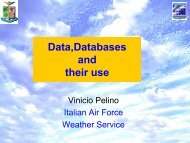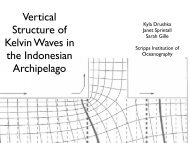Fabien Solmon Laboratoire d'Aérologie Toulouse (LA) solf@aero ...
Fabien Solmon Laboratoire d'Aérologie Toulouse (LA) solf@aero ...
Fabien Solmon Laboratoire d'Aérologie Toulouse (LA) solf@aero ...
You also want an ePaper? Increase the reach of your titles
YUMPU automatically turns print PDFs into web optimized ePapers that Google loves.
Interactions between climate and atmopheric chemistry over West Africa<br />
<strong>Fabien</strong> <strong>Solmon</strong><br />
<strong>Laboratoire</strong> d’Aérologie <strong>Toulouse</strong> (<strong>LA</strong>)<br />
<strong>solf@aero</strong>.obs-mip.fr<br />
PART 1 : Dust / African monsoon interactions<br />
PART 2 : Challenging scientific issues involving west african climate and atmospheric chemistry<br />
Thanks to …<br />
ICTP<br />
Abidjan and Niamey<br />
University<br />
<strong>LA</strong><br />
A. S. Zakey, F. Giorgi … A. Konaré , S. Ibrah<br />
M.Mallet , E.M Assamoi, F.<br />
Malavelle, C. Liousse, B.<br />
Guillaume …
Dust / African monsoon interactions<br />
Key question : Role of dust aerosol direct (and semi-direct) radiative effect on<br />
monsoon dynamic and regional precipitations.<br />
Weather system scale<br />
Meso-scale models can show contrasted responses to regional dust radiative forcing, depending<br />
on regions of interactions, system dynamical features, dust load and vertical distribution ..( e.g<br />
Grini et al., 2006; Chaboureau et al. 2007, Mallet et al. 2009 …)<br />
Climate time scale (GCM studies)<br />
Monsoon and precip weakening by dust<br />
Yoshioka et al.,2007<br />
Monsoon and precip strenghtening by dust<br />
Lau et al., 2009<br />
Regional climate approach
Incoming<br />
solar flux<br />
F F 0 .R<br />
0<br />
absorption<br />
scattering<br />
F 0 .e -AOD<br />
surface<br />
Aerosol optical depth AOD describes the<br />
aerosol extinction due to the sum of absorption<br />
and scattering effects.<br />
Scattered fraction R : depends on surface<br />
albedo, incident radiation angle , AOD,<br />
absorption and scattering properties of<br />
aerosols<br />
Dust Short Wave radiative forcing<br />
Outgoing flux<br />
TOA SW Radiative forcing : difference of<br />
outgoing fluxes without and with aerosol<br />
All other atmospheric and surface variables<br />
being fixed.<br />
> 0. = warming of the system<br />
< 0. = cooling of the system<br />
Dust<br />
Refractive<br />
index<br />
Mie theory<br />
SRF SW Radiative forcing : difference of<br />
net flux at the surface<br />
Always < 0. = cooling of the surface<br />
Extinction cross section (Qext, m 2. g -1 )<br />
Single scattering albedo (SSA)<br />
Asymetry parameter (g)
Dust Long Wave radiative forcing<br />
Atmospheric layers absorb and emit (grey body) in thermal radiation range.<br />
Radiative equilibrium between layers<br />
TOA LW Radiative forcing : difference of<br />
outgoing fluxes without and with aerosol<br />
All other atmospheric and surface variables<br />
being fixed<br />
ABS<br />
EM<br />
surface<br />
SRF LW Radiative forcing : difference of<br />
net flux at the surface<br />
Always > 0. = relative warming of the<br />
surface …
A modelling approach …<br />
Regional Climate Model<br />
High resolution limited area models<br />
adapted to climatic simulations.<br />
Forced by analysis or GCM outputs.<br />
RegCM (ICTP/UNESCO, Trieste, it)<br />
Giorgi and Mearns (1999), RegCM special issue of JGR (1999)<br />
…<br />
RegCNET<br />
Special Issue of Theor., Apl., Clim., sep 2006
Aerosols in RegCM<br />
Tracer model / RegCM3 (<strong>Solmon</strong> et al., 2006; Zakey et al., 2006)<br />
∂χ<br />
= −V<br />
∂t<br />
⋅∇χ<br />
+<br />
F<br />
H<br />
+<br />
F<br />
V<br />
+ T<br />
CUM<br />
+<br />
S<br />
χ<br />
−<br />
R<br />
w,<br />
ls<br />
−<br />
R<br />
w,<br />
cum<br />
−<br />
D<br />
dep<br />
+ ∑ Q − Q<br />
p<br />
l<br />
Transport<br />
Primary<br />
Emissions<br />
Removal<br />
terms<br />
Physico – chemical<br />
transformations<br />
Particles and chemical species considered<br />
SO --<br />
4<br />
BC(soot)<br />
OC(total organic carbon)<br />
DUST(4 bins)<br />
SO 2<br />
Presribed emission inventories On line emissions<br />
SO 2<br />
0.01-1<br />
Aqueous and gazeous<br />
conversion<br />
(Qian et al., 2001)<br />
Hydrophilic<br />
(20% at<br />
emission)<br />
Hydrophobic<br />
(80%at<br />
emission)<br />
Hydrophilic<br />
(50%at<br />
emission)<br />
Hydrophobic(5<br />
0%at<br />
emission)<br />
0.01-1<br />
µm<br />
1-2.5<br />
µm<br />
2.5-5<br />
µm<br />
5-20<br />
µm
dust aerosol module in the ICTP RegCM3 model<br />
Dust module in RegCM3<br />
Marticorena and Bergametti, 1995.<br />
Alfaro et al., 1998.<br />
Saltation<br />
wind<br />
Soil granulometry<br />
10 µm – 10000 µm<br />
0.01 – 20 µm<br />
Transport and<br />
removal<br />
Sand-blasting<br />
Surface properties<br />
(roughness, humidity, vegetation)<br />
Radiation scheme<br />
absorption<br />
diffusion<br />
emission<br />
(SW+LW)<br />
SVAT scheme<br />
⎡∂T<br />
⎤<br />
δ ⎢ t ⎥<br />
⎣ ∂ ⎦<br />
rad<br />
δF<br />
LE , H<br />
RegCM3 regional<br />
climate model
dust animation (February 2000)
Validations …<br />
MODIS<br />
‘Deep blue’<br />
AOD<br />
MAR 2006<br />
RegCM<br />
AOD
Seasonal scale …<br />
1.5<br />
MISR AOD<br />
JJA<br />
(2000-2006)<br />
RegCM AOD<br />
Vertical extinction<br />
profiles …<br />
RegCM<br />
Lidar<br />
M’Bour<br />
Senegal
Dust impact on African Monsoon<br />
Control simulation : NODUST<br />
Dust simulation : DUST radiative impact (SW +LW)<br />
Experiments<br />
Simulation Period : 1996 to 2006, 60 km resolution<br />
Boundary conditions : NCEP 2 reanalysis<br />
(BATS, Grell)<br />
Sensitivity studies:<br />
Dust single scattering albedo : SSA<br />
(absorption properties)<br />
Sea surface temperature feedback
Dust radiative forcing (SW+LW), JJA 1996-2006<br />
MISR AOD<br />
RegCM AOD<br />
Consistent with Balkanski et al., 2007; Li et al., 2004
Average dynamical and precipitation response to dust over Sahel<br />
Konaré et al., 2008; <strong>Solmon</strong> et al., 2008<br />
( NODUST, JJA 1996-2006)<br />
Mean circulation at 865 hpa<br />
m.s -1<br />
( DUST -NODUST, JJA 1996-2006)<br />
Differential circulation at 865 hpa m.s -1<br />
mm/day<br />
15<br />
mm/day
Cloud water, meridional circulation and precip. difference (DUST-NODUST)<br />
15W-15E<br />
JJA 96-06<br />
average<br />
B :‘Elevated heat<br />
pump’ effect<br />
( Lau et al. 2009)<br />
A :Reduction of<br />
‘monsoon pump’<br />
Precip difference<br />
(DUST-NODUST)
A : Reduction of ‘monsoon pump’ intensity …<br />
Sensible heat flux difference (DUST-NODUST)<br />
W/m2<br />
Measured Impact of dust on sensible<br />
heat flux during the March 2006 SOP<br />
Cooling of the Lower troposphere and reduction of the moist<br />
static energy gradient.<br />
Moist Static Energy gradient
B: Elevated heat pump …<br />
15W-15E<br />
JJA 96-06<br />
average<br />
B :‘Elevated heat<br />
pump’ effect<br />
( Lau et al. 2009)<br />
Dust SW<br />
radiative<br />
heating ….<br />
Can create positive<br />
anomaly of CAPE
NODUST<br />
1996-2006 average precip<br />
mm/day<br />
DUST<br />
longitude<br />
June<br />
July<br />
Aug.<br />
… Signature of both effects on weather systems (easterly waves)…
Response to dust forcing vs. Precipitation bias.<br />
mm/day<br />
R egio n<br />
(1 5W -15E a vera g e)<br />
5 N – 10 N<br />
10 N – 17 N<br />
1 7-N 2 0 N<br />
O B S<br />
C R U<br />
T R M M<br />
C R U<br />
T R M M<br />
C R U<br />
T R M M<br />
B ias<br />
(m m /d ay a n d % )<br />
(D U S T –N O D U S T )<br />
(m m /d ay a n d % )<br />
-1.23<br />
(-2 0.3 % )<br />
-0.18<br />
(-3.0 % )<br />
-1 .2 3<br />
(-2 4% )<br />
-0 .1 9<br />
(-3 .8 % )<br />
+ 1 .0 9<br />
(+ 2 0% )<br />
-0 .42<br />
(-7.9% )<br />
+ 0.06<br />
(+ 1.4% )<br />
-0.2 8<br />
(-6 .1 % )<br />
-0.23<br />
(+ 41% )<br />
-<br />
+ 0.04<br />
(+ 7.4 % )<br />
-0.41<br />
(-92% )<br />
+ 0.05<br />
(+ 1 1.3% )<br />
Im p rov m en t ?<br />
n o<br />
n o<br />
yes<br />
yes<br />
yes<br />
yes
Climate sensitivity to dust absorption properties<br />
Variability of measured values of dust single scattering albedo values (mineral<br />
composition, coating, aerosol size distribution ..) : impacts on the climatic response ?<br />
Standard case<br />
More absorbing dust<br />
Very diffusive dust<br />
SSA ~0.95 (fine dust) SSA ~0.90 SSA ~0.99
Simulated precipitation anomaly over the ocean ?<br />
JJA 96-06<br />
mm/day<br />
Strong elevated heat pump effect …<br />
Over ocean only the diabatic heating<br />
contribution is efficient since SST are<br />
forced in standard simulations …<br />
PSEA (dust – nodust )+ dif. circulation<br />
cbar<br />
kg/kg
Simple SST experiment : SST* = SST - 0.8 x AOD<br />
as a result of downward SW attenuation at the surface<br />
(consistent with Evan et al., 2009, Yoshioka et al.,2007)<br />
T2m dif. (DUST –NODUST)<br />
STD case<br />
K<br />
T2m dif. (DUST –NODUST)<br />
SST* case<br />
K
STD case<br />
SST* case<br />
PSEA dif (dust –nodust)<br />
cbar<br />
PSEA dif (dust –nodust)<br />
cbar<br />
mm.d-1<br />
mm.d-1<br />
With SST* correction :<br />
Same kind of response over land ..<br />
a weaker dust induced cyclonic anomaly and less precipitation are obtained over ocean …
STD case<br />
SST* case<br />
Evap dif (dust –nodust)<br />
mm.d-1<br />
Evap dif (dust –nodust)<br />
mm.d-1<br />
Decrease of local humidity source<br />
available for deep convection<br />
… Need for regional Ocean coupled model to fully asses the regional climate<br />
response to aerosol forcing over Ocean …
Conclusion part 1<br />
•Regional precipitation responses depend on coexisting differential circulations patterns induced by the<br />
dust radiative forcing at different tropospheric levels.<br />
•Surface and lower troposphere cooling induces a decrease of the monsoon pump intensity whereas<br />
atmospheric diabatic warming over the source areas trigger an elevated heat pump effect resulting in<br />
enhanced convection and cloud formation in the higher troposphere over the Sahel.<br />
•The net regional impact of dust on average precipitation results from these coexisting effects. Drying is<br />
dominant over Sahelian region except for a limited band over northern Sahel which sees enhanced<br />
precipitations. Model precipitation bias is positively impacted when dust are accounted for.<br />
•The balance between these effects is very sensitive to the dust SSA which affects the intensity of<br />
precipitation decrease vs. increase as well as the latitudinal limit between these two responses.<br />
•When SST are prescribed to the model, only diabatic warming is effective and more convection and<br />
precipitation are obtained in the dust outflow region. When SST are allowed to feedback (cooling due to<br />
decrease of incoming SW radiation) the response could be of opposite sign due a decrease of latent heat<br />
and moisture availability for deep convection.
Interaction between atmospheric chemistry, climate, and biogeochemical cylces over<br />
West Africa : scientific context …<br />
Intercontinental transport<br />
Global chemistry<br />
O 3<br />
OH<br />
etc<br />
Heterogeneous chem.<br />
gas/ particles /clouds<br />
Climate change<br />
Regional dynamics<br />
Radiative forcings<br />
Deposition<br />
SO 4<br />
RCOOH<br />
O3<br />
H2O<br />
HNO3<br />
OC<br />
DUST<br />
VOC<br />
NH3<br />
etc …<br />
NOx<br />
BC<br />
OCEAN<br />
Regional climatic and<br />
Environmental impacts<br />
TROPICAL FOREST<br />
SAVANE HUMID SEMI-ARIDE<br />
SAVANNAH<br />
Primary Emissions<br />
Anthro. pressure<br />
DRY SAVANE SAVANNAH ARIDE<br />
DESERT
e.g observed aerosol mixture ( MODIS obsrevation, june 4 2004)
Source SWAC, 1998
Large and increasing anthropogenic emissions in Africa<br />
Diversity of emissions and complexity of tropical atmospheric chemistry<br />
(Natural and anthropogenic compounds)<br />
Sensitivity of societies and ecosystems to environmental change<br />
Scientific challenges ….<br />
To better understand complex climate / chemistry interactions over Africa.<br />
To perform regional impact studies using emission, land use change and climate<br />
scenarii.
Aerosol feedback on regional climate.<br />
Role of anthropogenic and natural aersosol (Dust, biomass burning, energy …)<br />
aerosols via direct and indirect effects …<br />
Haywood et al., 2008, JGR<br />
Dry season
Observation and simulation of aerosol hygroscopicity within convective systems ( from<br />
Crumeyrolle et al., 2009, ACP)
Aerosol sectional model qqs-<br />
40µm<br />
Gaseous chemistry<br />
in each bin:<br />
Absorption/adsorption<br />
+ internal equilibrium<br />
SO 2<br />
NOx<br />
COV<br />
Inorganic<br />
Condensable<br />
H 2<br />
SO 4<br />
NH 3,<br />
HNO 3<br />
Organic<br />
Condensable<br />
SOAA, SOAB<br />
Water<br />
sulphate<br />
SOAA<br />
SOAB<br />
OCp<br />
BC<br />
sea-salt<br />
dust<br />
nitrate<br />
pH<br />
ammonium<br />
Optical<br />
properties<br />
Hygroscopic<br />
properties
Biogeochemical feedbacks…<br />
e.g. 1 Deposition of nitrogen to savannah ecosystem ..<br />
Nitrate associated to dust large particles ( IDAF / Lamto / ivory coast )
e.g. 2 : Dust iron solubility and bioavailability to the Atlantic ocean ecosystems<br />
Influence of mineralogy ( Journet et al., 2009)<br />
Influence of atmospheric processing ( Desboeufs et al;, 2008)
Impact of regional processes on global chemistry and regional air quality<br />
Ozone, particles …<br />
e.g. : monsoon dynamic and inter-hemispheric transport of ozone ..
THANK YOU !






